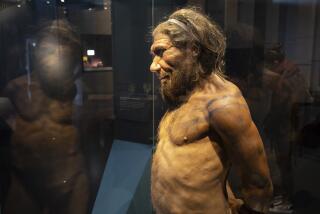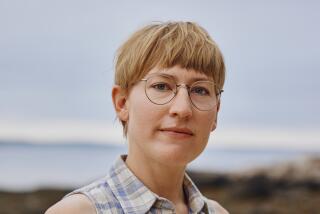From cads into smooth-talking gentlemen
- Share via
In the beginning there were animals, and when one wanted to rut the other wanted it also. Thus there was mating and satisfaction in the animal kingdom. But then came humans, and suddenly women no longer wanted just to “do it.” They wanted to talk too. And so humanity’s troubles began.
If humans are defined as the talking animal, then, as a recent New Yorker cartoon suggested, it was woman, not man, who drove the development of language and thereby kick-started our species. Here, as in countless jokes and cartoons, speech is disparaged as an unnecessary burden imposed upon men by women. Why do women want to complicate everything by talking? What do they hope to achieve by this means? In other words, what do women want?
This, according to Leonard Shlain, is the oldest human dilemma, and it is the starting point in his new book, “Sex, Time and Power,” for a wide-ranging ramble on the question of human evolution and the problems of sexuality and language. Starting from these critical issues, Shlain wades into the waters of evolutionary psychology, the new science that attempts to explain human behavior and culture in terms of Darwinian evolution. Shlain begins by acknowledging that human life is built not on a harmony between the sexes but on a fundamental disparity. How did this difference arise, and do we, as he ultimately suggests, gain something “higher” because of it?
“Sex, Time and Power” itself evolved out of questions left over from Shlain’s highly successful previous book, “The Alphabet Versus the Goddess,” in which he explored the role played by the development of writing in the formation of patriarchal social systems. Since patriarchy predates a formal alphabet, Shlain realized he needed to probe farther back in time. One night, on a long drive between signings for the “Alphabet” book, he was hit by a visionary synthesis linking the origin of women’s suppression and the origin of language itself to the basic physiology of female anatomy.
Human females are the only creatures who undergo full menstruation, an innovation that sets us apart from all other animals. Most creatures signal their readiness to mate during periods of estrus; they do not bleed each month. By doing so, Shlain says, women’s health is endangered -- they are depleted of iron and in danger of chronic anemia. A further puzzle arises: As the menstrual cycle was established, evolution was leading our species toward a precarious threshold, for the head of the fetus was becoming so large that it endangered the very life of the mother in childbirth.
According to Shlain, women’s menstruation, undulating to the rhythms of the moon, enabled them to develop a sense of time and hence forethought. By linking the sexual act to the dangerous miracle of birth nine months later, women began to realize that sex had life-threatening consequences. With that knowledge came the need to determine with whom they would have conjugal relations. In short, Shlain says, women developed first the will and then the power to say no. Original Sin was replaced by “Original Choice.”
The foregoing logic is somewhat opaque, for if women became aware that in having sex they were risking their lives, surely they would have been better off refraining. Why choose at all? Shlain himself admits the point, but he has an answer: Because of their regular periods, women needed iron; men could supply it by bringing them meat.
Armed with her new knowledge, Pleistocene woman understood that she had to weigh the men who paraded before her. In the face of her denial, man himself had to develop new interpersonal skills. He learned quickly, Shlain theorizes, “that speech was the well-oiled vehicle he needed to convince a woman, over time, that she should be his.... In short, language evolved primarily because men and women had to negotiate sex.”
Shlain speculates that in the mists of our dim past “[s]ome nervous young man tentatively approaching a young woman who had caught his eye” struck up a conversation and “thus was born, on a Pleistocene summer evening, the ‘opening line.’ ” Probably, he tells us, it was “an ancestral version of ‘Saaay, you look familiar. Haven’t we met somewhere before?’ ” On that enchanted evening a pattern was set. Men began practicing their conversational styles, trying out strategies from suave and charming to macho, intellectual and witty. “It would not have been lost on such a clever creature as Homo sapiens that a man who was short and homely but could make a woman laugh was more likely to be a successful wooer than a strong silent type,” Shlain writes, apparently in all seriousness.
But language proved to be a double-edged sword. If woman now had a means for assessing her suitor -- was he smart and funny, or humorless and dull? -- language was also a tool of deception, for silky words often hide a ruthless heart. “Did the character of this man blah-blahing before her possess the staying power to see her through the five children, two miscarriages, illness and wrinkles?” Shlain asks. “Or was he the sort who would abandon her and their brood for younger, greener pastures?”
With the invention of language and the power to say no, woman found herself in a bind: She must “endure a seemingly endless procession” of silver-tongued suitors, withholding herself until the appearance of “the One [who would] forgo his freewheeling ways and pledge himself to her.” She must become “expert at reading between the lines.” Happily, there was the girlfriend factor: Pleistocene woman did not ponder these matters alone; she had friends with whom she could endlessly analyze the stream of potential mates -- all the while doing her hair.
In order to exercise Original Choice, a woman must actually have choices. Yet Shlain suggests that without the overt signals of estrus, primitive man was in danger of losing interest (a suggestion that comes as a bit of a surprise). Fortunately, nature provided an alternative mechanism to keep the fellows panting -- in a word, beauty. And according to Shlain, nothing epitomizes the lure of female beauty more than hair, a leading signifier of youth and vitality. “No other female animals feel compelled to wash, shampoo, curl, perm, or style their crown tufts,” he writes. “Lionesses never experience a bad hair day.”
All cultures need myths about how we came to be human. As Claude Levi-Strauss has noted, the primary function of myths is to articulate a story not of material genesis but rather of the coming into being of humans as psychological and cultural beings. As long ago as the 18th century, John Locke claimed that a stable society required more than a material science and that sooner or later Western civilization would have to devise a science of the psyche. That is what Freud set out to do. Rejecting this psychoanalytic trend, evolutionary psychologists are attempting to give us a new story of human psychosocial development. Most of their theories are thinly veiled attempts to justify right-leaning social agendas. Shlain sees through this bias and is clearly attempting to counter it with an alternative story of a more left-leaning and romantic stripe.
“Just So” stories are what Stephen Jay Gould called the bulk of evolutionary psychologists’ theories. A penetrating thinker and famous lefty, Gould could see through the scientific veneer of these right-wing masquerades in an instant, yet those on the left must be equally alert to abuses of science perpetrated on their side of the fence. Shlain wants to help redress the inequity between the sexes, and he is stirred by a vision of men and women (inspired, he confesses, by the bliss of his second marriage) transcending their history and achieving harmony at last. This is laudable. But in our desire to find a more congenial future for our species, it will not do to invest our past with pseudoscientific fables.
Shlain’s book ought to be read as a morality tale. By articulating an alternative vision that is no more nor less grounded in data than are most other hypotheses of evolutionary psychology, he exposes the tenuous roots of all such stories. As Aesop might have said: “Well, I’ve got a theory of evolution too.” *
More to Read
Sign up for our Book Club newsletter
Get the latest news, events and more from the Los Angeles Times Book Club, and help us get L.A. reading and talking.
You may occasionally receive promotional content from the Los Angeles Times.







